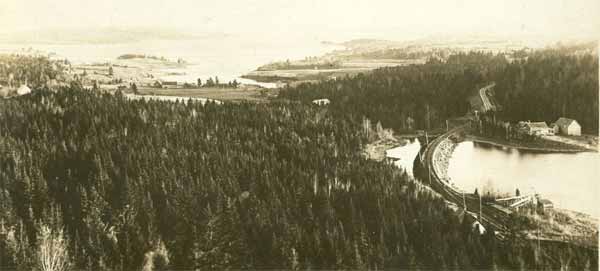History
- Details
- Hits: 16120
We are fortunate to have access to materials, which paint a picture of the activities that have taken place in our Watershed over the last two hundred years. Today, the Watershed is comprised of six lakes, but this was not always the case.
In the late 18th Century, a canal was excavated from Limeburner Lake to Little Chamcook Lake to add this 480 acre drainage area to the system. Formerly, Limeburner Lake drained into the Waweig estuary by means of a stream, which was closed by a dike at the time the canal was constructed.
The earliest recorded industry to capitalize on the waters of Chamcook Lake was a paper mill built by Squire John Wilson, who had also built the first dam on the system. By 1835, he had also built a grist and three sawmills on the Chamcook stream, all powered by the water flowing in the stream.
The Wilson estate, including the dam, were later purchased by an Irishman, Mr. David Rankine, and in 1890 he built the Rankine Mill, which operated until 1965, turning out boards and laths for local markets.
Other entrepreneurial ventures operated concurrently with the milling operations. Mr. George Higgins of St. Andrews inherited a business from his father, that of cutting ice in the winter. Before the days of refrigeration, blocks of ice, 18 inches by 36, were sawn by hand from the lake ice and transported by teams of horses to the Higgins Ice House in St. Andrews. A typical winter would involve the harvesting of 350-400 tonnes of ice blocks, which would be stored under a deep layer of sawdust for the summer months. Higgins maintained a steady clientele of about 75 customers, who received their ice four times weekly for $4 per month.

Chamcook Lake was also used for commercial harvest by American interests as far back as 1887, who used the rail system to transport the product to St. Andrews, from where it was then shipped to markets in the Boston area.
In 1888, the St. Andrews Land Company opened the doors of the new Algonquin Hotel, and in that same year filed for and received approval to tap Chamcook Lake for drinking water. It was not, however, until 1911, when the existing well-water supplies proved insufficient, that an 8-inch pipeline was installed. This was a seasonal arrangement, with the system being drained in the autumn to prevent freezing damage. As a result of this arrangement, the original Algonquin burned to the ground in April of 1914 when a fire broke out, and there was an insufficient quantity of water with which to extinguish the blaze.
The growing community of St. Andrews experienced a number of hot, dry summer seasons in the ensuing years, which stretched the capacity (24 000 gallons per hour) of the existing 8 inch line, and eventually, in 1952, it was replaced with a 10-inch line which could provide 45 000 gallons per hour.
In 1967, a new pipeline was built on the west side of Chamcook Lake to provide water for the Champlain Industrial Park, and a few years later, in 1972, the Rankine family signed a deed of transfer to the International Salmon Foundation, transferring the dam and the Rankine property to ISF ownership. (ISF was shortly thereafter renamed the Atlantic Salmon Federation.)
In 1974, ASF constructed its own pipeline to draw lake water, and built the hatchery and production facilities that exist there to this day.
This short document cannot, obviously, encompass all the details involved in a history spanning several centuries. It is hoped, however, that this brief history will provide you with a few glimpses of relevant moments through the years.



